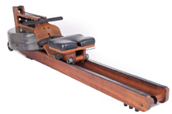Can Industrial Designs Be Protected by Copyright in the United Kingdom? The WaterRower is Not Protected by Copyright in the United Kingdom
Earlier this week, the Intellectual Property Enterprise Court (IPEC) handed down the long-awaited decision in the WaterRower v Liking [2024] EWHC 2806 (IPEC) case. It is seen as a key judgement exploring the boundaries of copyright protection in the United Kingdom.
The case originated from an enforcement action against Liking Limited and dealt with the question whether the WaterRower (shown below) should be considered as a “work of artistic craftmanship” under s 4(1)(c) Copyright, Designs and Patents Act 1988 and therefore should be protected by copyright, or whether the design of the WaterRower is merely dictated by its technical function.

Work of Artistic Craftmanship
In its judgement, the IPEC considered evidence showing the significant effort and skill that was put into the creation of the WaterRower, including material choice, the shape and the finish of the machine, as well as the commercial success of the machine, the public’s high regard for the quality of the design, and the fact that there appeared to be considerable room for the designer to make choices on the design and shape of the machine.
However, the IPEC concluded that the evidence did not give the impression that the WaterRower was the result of “a mind with a desire to produce something of beauty which would have an artistic justification for its own existence”. In addition, the designer was not an artistic craftsman, namely that he “was not an artist in that he used his creative ability to produce something which has aesthetic appeal”.
Accordingly, the IPEC found that the WaterRower was the result of a commercial development with a focus to create a commercially successful rowing machine. Therefore, the designer did not have the intention to create a work where the craftmanship in its creation was artistic. The fact that the designer aimed to create a rowing machine with a sensory and visual experience that differed from existing rowing machines, was not sufficient to conclude the WaterRower is a work of artistic craftmanship, and Liking Limited did not infringe copyright by selling their machines.
Conflicting EU and UK Law
In the decision, the IPEC also addressed the differences between copyright protection under UK and EU law. Prior to assessing whether the WaterRower is a work of artistic craftmanship, the IPEC dealt with the question whether the WaterRower could be considered as “original” within the meaning of the InfoSoc Directive. The IPEC concluded that, although the prototype is technically restricted in certain aspects that help achieve the technical result of the machine, the shape was not solely dictated by its technical function and the WaterRower reflected sufficient visual elements that were an expression of free and creative choices of the designer. As such, the WaterRower would pass this “broader test” and enjoy copyright protection under EU law.
Conclusion
This decision shows that the UK approach to copyright remains restrictive and is diverting from the more recent EU caselaw, namely Cofemel and Brompton, is now on paper and will have to be addressed by higher courts or primary legislation. For the time being, designers should consider that copyright protection is subject to more stringent criteria in the United Kingdom and separate advice is required when it comes to enforcement actions.
By Serena Totino and Sophie Verstraeten
